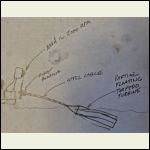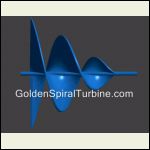|
| Author |
Message |
reddly
Member
|
# Posted: 8 Mar 2012 06:40am
Reply
alright not sure why this wouldn't work exactly but maybe someone can explain.
if i was to use a windmill/water wheel why could i not have it attached to a large gear(a) (or wheel with teeth) and have that connected to a smaller gear(b). then have gear B connected by shaft to a larger gear c which is then connected to small gear(d).
if (a) turned a full turn it would turn, (b) would turn say 20 times (think big wheel and little wheel touching it. the big wheel turns the little wheel turns more times)
of course this would mean that gear (c) being connected with a rod to (b) would turn at the same rate. 20 times.
finally getting to gear (d) assuming its connected to a generator or turbine. say it has the same 20 ratio.
so the water wheel turns 1 full turn. gear b does 20 turns, gear c does 20 turns, gear d does 400 turns.
Obviously this depends on the size and number of teeth on each gear but how does this relate to power generation??????
I may have found a large property that sits along 1 side of a very large slow moving river. this would allow me to effectively increase how fast the water is moving. my water wheel could turn slowly and the result on the turbine or generator or whatever (most likley a reversed alternator) would be it spinning like crazy.
Help me out here, I'm not seeing a downside or how this doesn't work.
|
|
Martian
Member
|
# Posted: 8 Mar 2012 07:26am
Reply
I'm not an engineer nor did I play one on TV, but experience has shown me that the determining factor of power out is power in. If you're able to put a large enough paddle into the water, there is no reason you couldn't do this. But you will have to deal with varying water flow rate and height; not to mention floating debris fouling the water wheel.
Tom
|
|
reddly
Member
|
# Posted: 8 Mar 2012 08:00am
Reply
I was considering a ship mill, so in theory it would be a large paddle. start talking paddle wheel size. power out = power in, law of conservation of energy. thats the part that troubled me. it seems like you are getting free power out.
water flow problem would be taken care of by the ship (always floating on the water, high or low)
debris was something i had not considered. hmmm perhaps a grate.
Thanks for the help.
does anyone have micro hydro ? I'm going to start searching on power output but a large wheel should offer quite a lot of electricity output. I figure something comparable to a not so backyard size wind generator.
|
|
Martian
Member
|
# Posted: 8 Mar 2012 09:23am
Reply
Reddly, the first thing I would do, since I'm not a math wizard, is build a paddle, attach a scale to it to measure the pressure, anchor a boat in the river, and see how much energy you have to work with. It may be you are going to need a very large wheel to get the torque you need.
While it is a very fun exercise, I don't see how it is going to be practical by the time you spend the money for the initial build and then maintain the system. Spend a little time Googling. I did a quick search and found several discussions.
Tom
|
|
groingo
Member
|
# Posted: 8 Mar 2012 10:18am - Edited by: groingo
Reply
I built one similar to this that floated on pontoons and was cabled to land based supports so when the water rose and fell the thing wouldn't wash away.
Problem was that to produce the amount of foot pounds of torque needed to drive a gearbox and thus spin the generator the current, depth of dig (paddle into the water) etc., long story short it couldn't produce the power needed to generate significant energy....but this guy is definitely on the right track....see here: http://www.hydro-electric-barrel.com/
The good thing about surface tension hydro generators is they don't have the typical fish related problems and are very portable, now what we need is for the generator technology to catch up (more efficient).
P.S. Don't let anyone discourage you in this, if you have running water you have power, just need to get to it by looking outside the box.
|
|
MtnDon
Member
|
# Posted: 8 Mar 2012 10:23am
Reply
Gearing up in the order of 1:400 overall is a huge step. Have you tried riding a multi speed bicycle up a hill in top gear? Somewhat the same thing.
Before you start building paddles do a search for methods of how to determine the flow rate of the water. How many cu ft per minute or second, something like that can be used to compute the probable power output. Is there any drop to the water flow at all?
If the paddle can not produce enough torque to turn the geared up generator/alternator the water will simply spill past the paddle. It may need channeling or something.
Also in some places you will run into restrictions on what you can do with the water. Worst case in many places in the west is that an environmental impact study could be required.
|
|
MtnDon
Member
|
# Posted: 8 Mar 2012 10:28am
Reply
Article on Head and Flow
|
|
rayyy
Member
|
# Posted: 8 Mar 2012 06:10pm
Reply
I always wanted to play around with this idea too,Reddly.But to build a total experamental water wheele generator,,,It's over my head.I was gonna play with pullys and belt drives.You know a small pully driving a large pully,driving a small pully.ect,ect.Cranking an alternater.If you get it figured out,let us know.
|
|
|
Martian
Member
|
# Posted: 8 Mar 2012 08:09pm
Reply
On the sailboat, we drug a propeller off the stern which turned a DC generator via a speedometer type of cable. It took about 6.5 knots, roughly 8mph, to get much charge out of it, but with a steady flow, 24hrs/day, it would be worth it.
Tom
|
|
TomChum
Member
|
# Posted: 9 Mar 2012 11:19pm - Edited by: TomChum
Reply
Quoting: reddly gear d does 400 turns
You are thinking mostly right but be aware that 400:1 is HUGE.
The second hand on your grandpa's watch, to the minute hand, is 60:1
Note the friction at gear D is 400 times as well.
I think you might have some trouble even at 20:1, startup torque will be too high, the water will just go around the paddle.
|
|
reddly
Member
|
# Posted: 10 Mar 2012 06:58am
Reply
then i suppose my next question is, like a wind generator, the faster the wind travels the more power is produced. If the generator worked the same then.. if it turned slowly it would be a trickle but not much friction as it continued to get faster it produced more for the same friction???
isn't this how wind power works?
|
|
TomChum
Member
|
# Posted: 10 Mar 2012 09:29am - Edited by: TomChum
Reply
Yes the faster it turns, the more power is produced. One major difference is that the river doesnt slow down when the wind stops. It runs all day all night, on cloudy days too. 10 watts, 24 hours a day is the same as 60 watts four hours a day.
It would be a mechanical device, and running 24 hours a day it will have breakdowns.
|
|
reddly
Member
|
# Posted: 16 Mar 2012 07:34am
Reply
okay so i've done some more reading some more thinking some more everything.
things in my mind that I'm still looking for thought and advice on
1) the property has 2 rivers. 1 of them is about 20 ft wide, 8 ft deep, moves medium/slow I haven't managed to find the exact, but it seems like it will be able to turn a water wheel slowly but forcefully. hence the gearing up question.
the second river is way way to large for any sort of water wheel system. I mean this thing is massive at the point where the property is it must be over 100ft across.
anyways, gave the description to try and give people an idea of what i might work with if it was viable (help anyone whos tried?) I think I'm fortunate in that it doesn't have to be wood. which means some real light weight materials that are strong enough to do the job. less weight means less loss of energy on moving the wheel.
the size of wheel i'm thinking.. well i don't really know but off the top of my head thinking at least 6 ft long. at least 2 ft in the water. if theres 2ft in the water the diameter should be like 8ft.
so talking a big wheel, so the gear on the wheel (gear a from my OP) could be huge like 6 ft. it would turn so incredibly slow though. hence the gearing up question. I mean this is all random thoughts. am I even on the right track?
|
|
Martian
Member
|
# Posted: 16 Mar 2012 08:14am
Reply
Remember, if your paddle material weighs less than the water it displaces, then your paddles will try to float. Energy will be lost unless you have your paddles spaced to where one is rising at the same time the other is submerging. Anything you can do to prevent the water from flowing around the paddle will add to efficiency. Sideboards forming a funnel will add power.
Tom
|
|
reddly
Member
|
# Posted: 17 Mar 2012 07:22am
Reply
guess its time to build a mock up mini and see what might happen......
|
|
TomChum
Member
|
# Posted: 19 Mar 2012 01:08pm - Edited by: TomChum
Reply
Here's another idea if you have a vast-running and wildly variable stream. It seems like this could "clean" itself and not be bothered by logs or boulders coming down. It's a steel pipe about 10 inches diameter, that has some floatation, with steel spiral vanes. Torque is transmitted thru a flexible steel cable (wire rope). I'm not sure if this is my idea, or if I saw something similar, somewhere.
I enjoy DIY sites such as http://www.builditsolar.com/Projects/Hydro/FlowOfRiver/FlowOfRiver.htm
Lots of Pelton wheel type generators, but think how noisy a pelton wheel would be. I think you'd attract meth-heads to use your copper in their supply chain.
Searching more this morning reveals this one http://goldenspiralturbine.com/ The spiral looks like it would be difficult for a DIY but it looks "torquey". I searched "fast river generator" on Youtube.
There are a lot of other designs but these look like they might be self-cleaning.
Partial floating torpedo turbine
| 
Golden spiral turbine
|  |  |
|
|
Martian
Member
|
# Posted: 19 Mar 2012 01:16pm
Reply
Tom, that's the design I'd go with. Its the same principle as the generator we towed behind our sailboat. Actually the generator was on the boat. Just the turbine was in the water. It did collect some stuff, but surprisingly little.
Tom
|
|
vp
|
# Posted: 26 Mar 2012 10:39pm
Reply
find the rpm needed for your generator and use a simple rpm calibrator to get the pulley size you need to produce the maxim um generator output
|
|
|

